Key Points:
- The fer-de-lance, a venomous pit viper native to multiple countries in South America, is the deadliest snake in the Americas.
- The fer-de-lance has a hemotoxic venom that damages muscle tissue and breaks down proteins in the affected area. Humans bitten by this snake can suffer extreme pain, internal bleeding, impaired consciousness, sepsis, and necrosis of local tissues even with treatment.
- Because they can react quickly when threatened, and utilize a fake retreat tactic that takes predators and humans off guard, fer-de-lance snakes have even managed to kill herpetologists that have tried to catch them.
The Americas are home to many deadly creatures. From grizzly bears and jaguars to venomous snakes, many of these native animals can be dangerous to humans. However, some species of animal are deadlier than others, especially where snakes are concerned. That’s why we’re going to spend some time looking at the deadliest snake in the Americas. This creature goes by a lot of names, and you’ll learn them all before we’re done talking about this snake. Without further ado, let’s get to know the fer-de-lance.
What Is the Deadliest Snake in the Americas?

Fer-de-lance snake, coiled on a branch.
©David Havel/Shutterstock.com
The fer-de-lance is the deadliest snake in the Americas, and it earned that title for its potent venom and willingness to bite when cornered. This pit viper is also known to be unpredictable. In some cases, it will appear to retreat, only to turn around and bite the encroaching animal or human.
The fer-de-lance goes by a lot of different names. The binomial designation for this creature is Bothrops asper, but it also goes by terciopelo. The name “fer-de-lance” refers to the snake’s head shape that resembles the end of a lance. The head is thick and angled to a point at the creature’s mouth area.
For that reason, many English speakers will call this snake a lancehead even though that term applies to a lot of different creatures from the Bothrops family.
The name “terciopelo” means “velvet” in Spanish, and that name is one of many other interesting monikers for this snake. You’ll know the fer-de-lance by its large, broad, and flat head that is usually wider than the rest of its body. The snake’s head can be darker than its body, ranging from black to lighter shades of brown with the yellow from the animal’s underbelly appearing up to and around its eyes.
The snake has light and dark patterns across its body that are roughly triangular in shape. Mixed into the brown on their bodies are gray, olive, and black colors. The snakes are far from uniform, but they’re easily identifiable. Now that we know what the snake looks like, it’s time to consider how dangerous this creature can be.
What Makes Fer-de-Lance the Deadliest Snake in the Americas?
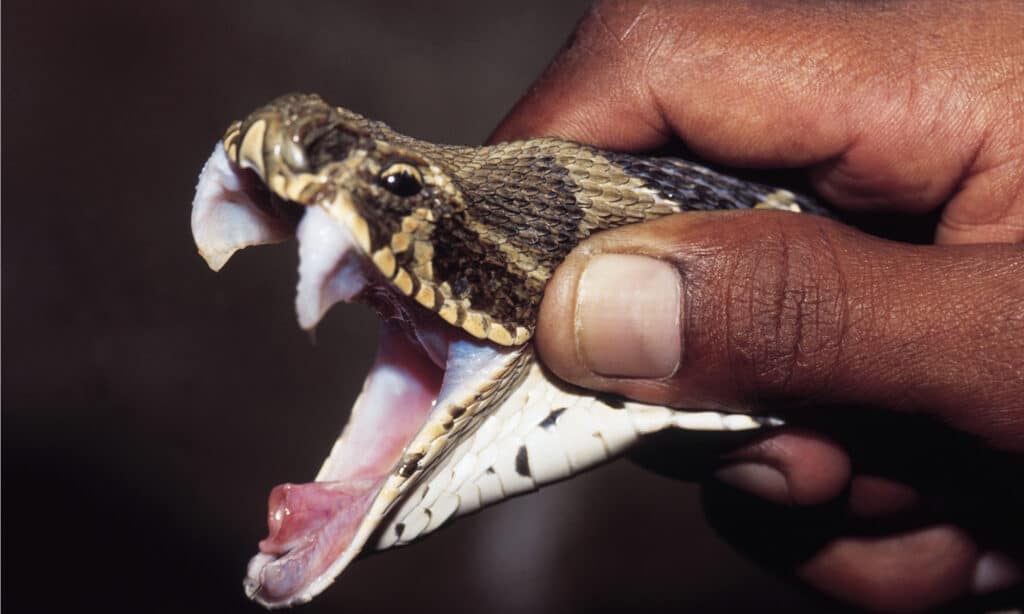
The fer-de-lance has a very powerful hemotoxic venom.
©RealityImages/Shutterstock.com
The fer-de-lance has a very potent venom that it uses to kill its prey. Unfortunately, that venom is just as potent against human beings as well. They have a hemotoxic venom that causes damage to the muscle tissue and breaks down proteins in the affected area.
Humans that are bitten by the fer-de-lance typically suffer from a great deal of pain at the bite site, internal bleeding, impaired consciousness, sepsis, and necrosis of local tissues even with treatment. These snakes are known for injecting a very large load of venom into their victims. The average bite yields about 458mg, and that is more than enough to kill a human being.
Death is a major concern from the snake’s venom, but tissue damage is as well. Many individuals lose their limbs to amputation after they are envenomated by the snake.
All in all, the snake’s venom is potentially lethal, but it also leaves many people disabled.
Where Does the Deadliest Snake in the Americas Live?

The fer-de-lance is home in many environments, including the rainforest.
©Fotos593/Shutterstock.com
The fer-de-lance is listed as one of the deadliest snakes in a variety of countries in Central America and South America. The snake can be found in many countries including:
- Honduras
- Mexico
- Costa Rica
- Ecuador
- Venezuela
- Panama
- Belize
- Colombia
- Nicaragua.
The snakes can be found in lowlands as well as in moderate elevations. They’re comfortable in a variety of biomes. You can find them in grasslands, rainforests, coastal areas, farmlands, and some mountainous areas.
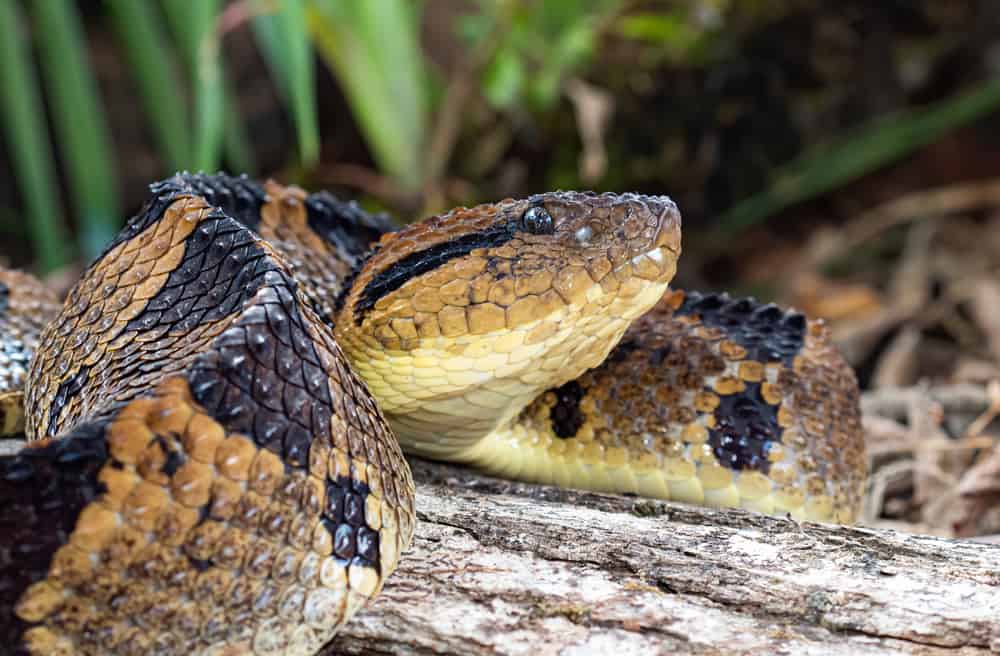
Image: Jim Cumming, Shutterstock
©Jim Cumming/Shutterstock.com
The fer-de-lance lives in the wild as well as near human settlements, hunting a variety of creatures and even scavenging when it needs extra food.
Fer-de-lance snakes are nocturnal creatures, going out at sundown to hunt along trails or roads. During the day, they spend their time coiled up in vegetation. While one may think they can avoid this dangerous snake if staying indoors at night, in Costa Rica alone, 550 people a year end up in hospital emergency rooms due to fer-de-lance snake bites.
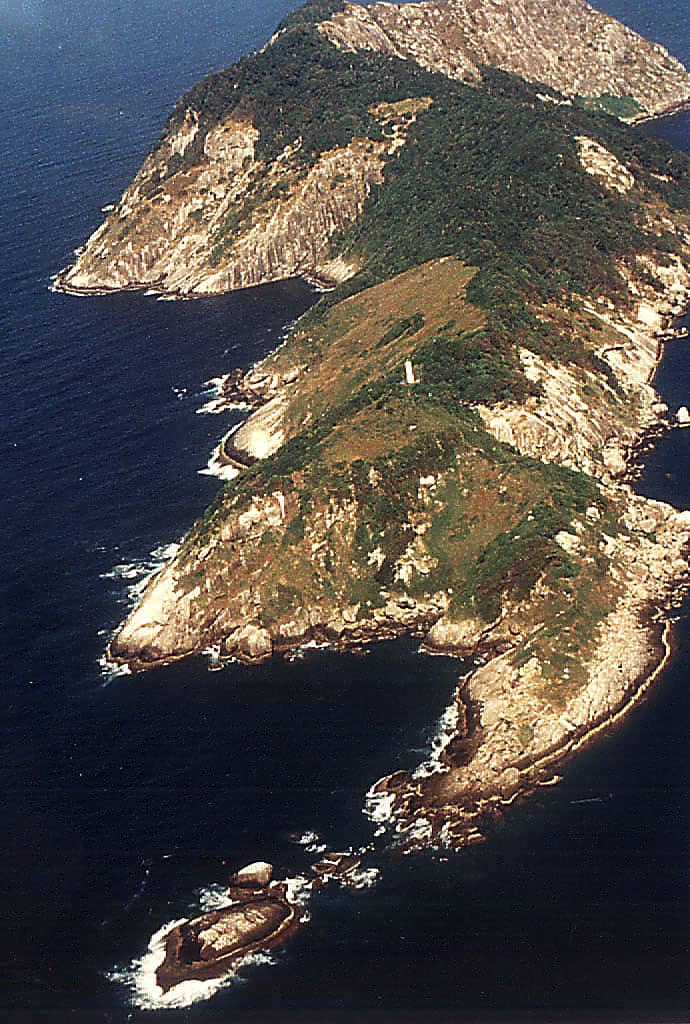
Roughly 3,000 golden lancehead snakes are believed to live on Snake Island
©Prefeitura Municipal de Itanhaém / Creative Commons – License
One species of the Bothrops family is well-known throughout the world for living alone on an island in South America. The Bothrops Insularis, the golden lancehead, is related to the fer-de-lance. This snake’s entire species is trapped on Ilha da Queimada Grande, also known as snake island.
This island is so densely packed with these deadly and endangered snakes that the entire area is closed to the public. Some estimates, probably embellished ones, say that there is one snake for 10 square feet on the island. Either way, this island is a place to avoid.
How Long Do Fer-De-Lances Live?
This super deadly snake has a pretty long lifespan. The Fer-De-Lance typically lives between 15 and 21 years. Reptiles tend to live longer than mammals of the same or similar size. Some scientists have found that their bodies’ cells do not show the same signs of aging as other animals.
What Other Factors Make the Fer-De-Lance So Deadly?

Fer-de-lance snakes are known for being nervous and unpredictable.
©Mark_Kostich/Shutterstock.com
The potency of the fer-de-lance’s venom is one factor that makes them deadlier than the average venomous snake. Another issue that we have already mentioned is their behavior. They will often feign retreat before turning around to bite their larger foe.
This fake retreat allows the enemy to get within biting distance and then all but ensures a bite while leaving an avenue for escape.
Another complication stemming from these snakes is their speed. While they are not as fast as a sidewinder, they can move and react faster than humans. They have managed to kill herpetologists that have tried to catch them using the fake retreat method along with their great speed.
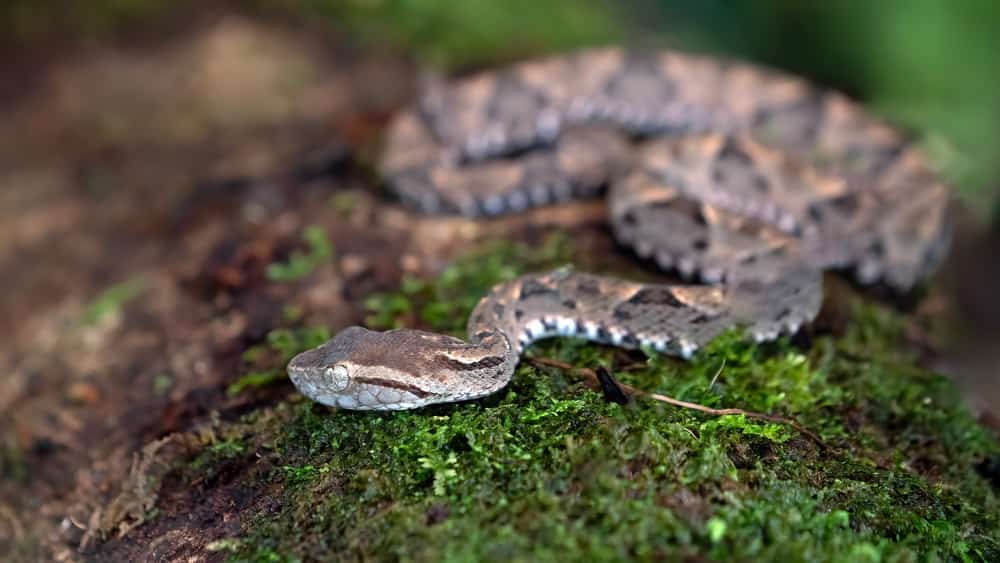
Image: Jack Nevitt, Shutterstock
©Jack Nevitt/Shutterstock.com
Lastly, fer-de-lances tend to live near human settlements in many countries. As the “Big 4” from India proves, putting too many people near venomous snakes greatly increases the chances of medically significant bites.
One study found that the average mortality of all snakebites in Nicaragua was about 25%, and most of the venomous snakebites that occurred in that country came from the fer-de-lance. This demonstrates the power of the snake’s venom and shows how, in an area with plenty of venomous snakes, the fer-de-lance stands out among the others.
In other countries, like Colombia and Venezuela, the fer-de-lance also represents a large number of medically significant snakebites. Fortunately, widespread development and distribution of snake antivenoms are decreasing the number of people that die as a result of this snake’s bite.
Nevertheless, the fer-de-lance is the most dangerous snake in the Americas. It causes more deaths and has deadlier venom than any other snake in this hemisphere!
Other Dangerous Snakes That Are Found in the Americas

The South American bushmaster is just one of the many deadly species of pit vipers found in the Americas.
©Patrick K. Campbell/Shutterstock.com
The pit viper family has many of the deadliest species of snakes. One of those is the South American bushmaster, also known as Lachesis muta or the Atlantic bushmaster, and is found in South America as well as the Caribbean island of Trinidad. It is the longest species of pit viper in the world and one of the largest venomous snakes in the Americas. They spend most of their time in ambush posture on the floors of forests or under vegetation and this snake is capable of injecting large doses of potent venom.

If bitten by the golden lancehead, you stand a 7% chance of death.
©Ko biet / Creative Commons – License
The golden lancehead is another highly venomous, and endangered, pit viper that is found in South America, specifically off the Sao Paolo coast of Brazil on Snake Island, that is incredibly deadly. Their venom can kill a person in less than one hour. If bitten by this viper, you stand a 7% chance of death, and even if you receive the treatment you still may die. The golden lancehead’s venom may cause necrosis, which is when the skin tissue dies, brain hemorrhaging, kidney failure, and even intestinal bleeding.
Other Non-Dangerous Snakes That Are Found in the Americas

The Emerald boa constrictor is also known as the green tree boa. They catch most of their prey while they hang from a branch to snatch them off the ground.
©Hannamariah/Shutterstock.com
Not all snakes are venomous and harmful. There are those that pose little to no danger to humans but should still be given plenty of space. The rough green snake, which is found throughout the southeastern United States, spends most of its time in trees since they are arboreal, and not much time is spent on the ground. They will rarely bite a human, as they have such a mild temperament, but they should still be left alone.
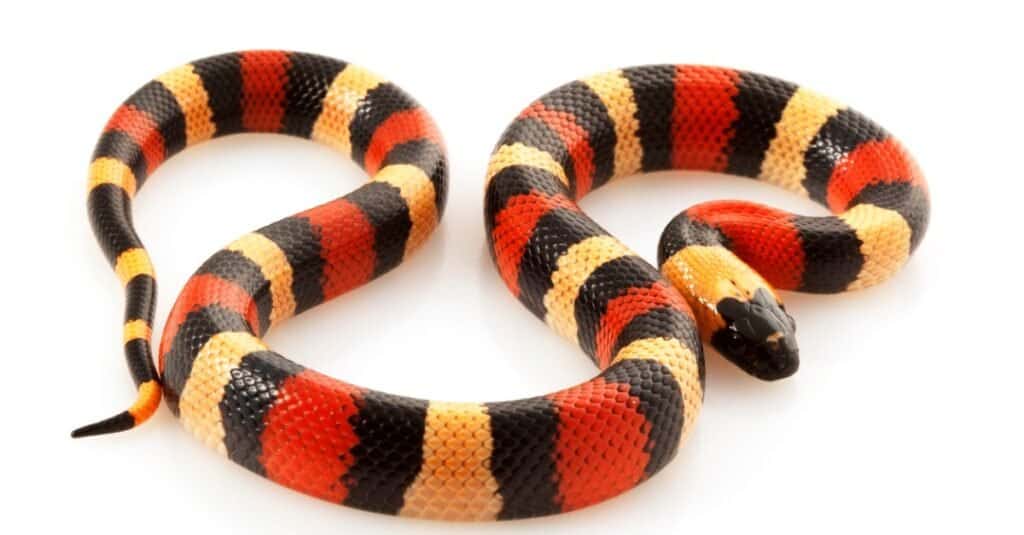
Milk snakes have a similar appearance to coral snakes.
©iStock.com/amwu
Milk snakes, while not an aggressive species, look very similar to the highly venomous coral snake. They can be told apart by the variations of the color bands: milk snakes have black bands next to red bands whereas coral snakes have red bands and black bands next to yellow bands. There is even a rhyme to remember it: “red on black friend of jack, black on yellow kills a fellow” or “red touch black; safe for Jack, red touches yellow; kills a fellow.” This rhyme can help identify a typically patterned Texas or eastern coral snake but is not valid with abnormally patterned snakes, some Sonoran (Arizona) coral snakes, and when outside North America.
The photo featured at the top of this post is © Mark_Kostich/Shutterstock.com
Discover the "Monster" Snake 5X Bigger than an Anaconda
Every day A-Z Animals sends out some of the most incredible facts in the world from our free newsletter. Want to discover the 10 most beautiful snakes in the world, a "snake island" where you're never more than 3 feet from danger, or a "monster" snake 5X larger than an anaconda? Then sign up right now and you'll start receiving our daily newsletter absolutely free.
Thank you for reading! Have some feedback for us? Contact the AZ Animals editorial team.






